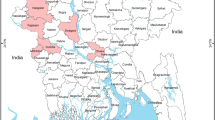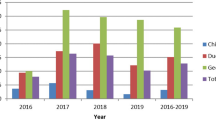Abstract
Co-infections of birds’ upper respiratory tract by avian pathogens are common and cause increasing economic losses. This study determines co-infection status of avian influenza (AI) and Newcastle disease (ND) in birds in two Nigerian states with different highly pathogenic avian influenza (HPAI) records and where modified stamping out policy contained the virus for seven years after which the virus resurged with higher infectivity in 2015. A cross-sectional study sampling 910 apparently healthy domestic and 90 wild birds from wild habitats, commercial poultry farms, households and live bird markets (LBMs) was conducted. Cloacal and tracheal swabs were tested for AI H5 and ND viruses using conventional reverse transcriptase polymerase chain reaction (RT-PCR). Overall detection rates of 3% and 18% for AI and ND were obtained. There was an equivalence of 8.5% ND detection rate in poultry and wild birds in the two states. Co-infection (0.2%) of a local chicken from a live bird market (LBM) and crown crane (Balearica regulorum) from a household to AI H5 and ND viruses occurred, respectively. Exposure of birds to AI and ND was significantly detected in apparently healthy domestic and wild birds. The probability of these viruses exchanging genetic materials to resurge with increasing virulence is foreseen. Therefore, routine AI and ND control measures should incorporate virus surveillance and instituting appropriate preventive measures in domestic and wild birds held in households, commercial farms and LBMs.

Similar content being viewed by others
References
Adu FD, Oyedeji O, Ikede BO (1985) Charecterisation of Nigerian strains of Newcastle disease virus. Avian Dis 29(3):829–831
Aldous EW, Alexander DJ 2001. Detection and differentiation of Newcastle disease virus (avian paramyxovirus type 1). Avian Pathology. 30(2):117–128.
Alexander DJ (2000a) Newcastle disease and other paramyxoviruses. Rev Scie Tech 19(2):443–446
Alexander DJ (2000b) Gordon memorial lecture. Newcastle disease. Br Poult Sci 42(1):5–22
Awan MA, Otte MJ, James AD (2012) The epidemiology of Newcastle disease in rural poultry: A review. Avian Path 23(3):405–423
Bello M, Lukshi MB, Sanusi M (2008) Outbreaks of highly pathogenic avian influenza (H5N1) in Bauchi state, Nigeria. Int J Poult Sci 7(5):450–456
Boroomand, Z., Jafari, R.A., Mayahi, M. 2018. Detection of Newcastle disease, H9N2 avian influenza, and infectious bronchitis viruses in respiratory diseases in backyard chickens in Ahvaz, Iran, in 2014-2015 Archives of Razi Institute, (73)1: 19-25
BSADP (Bauchi State Agricultural Development Programme Bulletin). (2003). pp. 6–12
Capua I, Alexander DJ (2009) The challenge of avian influenza to the veterinary community. Avian Pathology 35(3):189–205
Carrasco ADOT, Seki MC, De Freitas Raso T, Paulillo AC, Pinto AA (2008) Experimental infection of Newcastle disease virus in pigeons (Columba livia): Humoral antibody response, contact transmission and viral genome shedding. Vet Microbiol 129:89–96
Costa-Hurtado MAR, Afonso LC, Miller JP, Shepherd E, Smith D, Spackman E, Kapcynski RD, Suaez LD, Swayne ED, Patin-Jackwood JM (2015) Previous infection with virulent strains of Newcastle disease virus reduces highly pathogenic avian influenza virus replication, disease, and mortality in chickens. Vet Res 46:97–99
Cross G (1995) Paramyxovirus-1 infection (Newcastle disease) of pigeons. Seminars in Avian and Exotic Pet Medicine 2(4):92–95
Czeglédi A, Ujvári D, Somogyi E, Wehmann E, Werner O, lomniczi B (2006) Third genome size category of avian paramyxovirus serotype 1 (Newcastle disease virus) and evolutionary implications. Virus Research 120:36–48
Diel DG, da Silva LHA, Liu H, Wang Z, Miller PJ, Afonso CL (2012 Dec) Genetic diversity of avian paramyxovirus type 1: proposal for a unified nomenclature and classification system of Newcastle disease virus genotypes. Infect Genet Evol 12(8):1770–1779
Dimitrov KM, Ramey AM, Qiu X, Bahl J, Afonso CL (2016 Apr) Temporal, geographic, and host distribution of avian paramyxovirus 1 (Newcastle disease virus). Infect Genet Evol 39:22–34
Dimitrov KM, Abolnik C, Afonso CL, Albina E, Bahl J, Berg M, et al. (2019) Updated unified phylogenetic classification system and revised nomenclature for Newcastle disease virus. Infection, Genetics and Evolution
El Zowalaty ME, Chander Y, Redig PT, El Latif HKA, El Sayed MA, Goyal SM (2011) Selective isolation of Avian influenza virus (AIV) from cloacal samples containing AIV and Newcastle disease virus. Journal of Veterinary Diagnostic Investigation 23:330–332
EMPRES (Emergency Prevention System). (2015). H5N1 highly pathogenic avian influenza spread in Nigeria and increased risk for neighbouring countries in West Afria. EMPRES Watch, vol. 32 April 2015. http://www.fao.org/ag/empres.html
F.A.O (Food and Agricultural Organisation of the United Nations). (2007) Animal production and health manual: wild birds and avian influenza. pp. 1-113
Fasina FO, Meseko AC, Joannis TM, Shittu AI, Ularamo HG, Egbuji NA, Sulaiman LK, Onyekonwu NO (2007) Control versus no control; options for avian influenza H5N1 in Nigeria. Zoonoses Public Health 54:173–176
Fezel P, Mehrabanpour MJ (2018) Evaluation of the viral interference between lentogenic newcastle disease virus (Lasota) and avian influenza virus (H9N2) using real-time reverse transcription polymerase chain reaction in SPF chicken Braz. J Poult Sci 20(3). https://doi.org/10.1590/1806-9061-2017-0717
Fusaro A, Joannis T, Monne I, Salviato A, Yakubu B, Maseko C (2009) Introduction into Nigeria of a distinct genotype of avian influenza virus (H5N1). Emmerging Infectious Diseases, http://www.cdc.gov/EID/content/15/3/445.htm
Geo, F.B., Janet, S.B. and Stephen, A.M. 1998. Orthomyxoviruses (influenza viruses). Medical microbiology, 21st Ed. Appleton and Lange, pp. 506-516
GSADP (Gombe State Agricultural Development Programme Bulletin) (2003). pp. 9–17
Hassan KE, Shany SA, Ali A, Dahshan AHM, Azza A, El-Kady MF (2016) Prevalence of avian respiratory viruses in broiler flocks in Egypt. Poult Sci 95:1271–1280
Ismail ZM, EL-Deeb HA, EL-Safty MM, Hussein AH (2018) Enhanced pathogenicity of low-pathogenic H9N2 avian influenza virus after vaccination with infectious bronchitis live attenuated vaccine. Veterinary World, EISSN, pp 2231–0916 Available at www.veterinaryworld.org/Vol.11/July-2018/15.pdf
Jensen HT, Ajjouri G, Hanberg JK, Slomka JM, Cward JV, Cherbonnel M, Jestin VLP, Jorgensen HP (2013) An enzyme-linked immunosorbent assay for detection of avian influenza virus subtypes H5 and H7 antibodies. Acta Vet Scand 55:84–90
Joannis TM, Meseko CA, Oladokun AT (2008) Serologic and virologic surveillance of avian influenza in Nigeria. Eurosurveillance 13:42–48
Kayali G, Kandeil A, El-shesheny R, Kayed AS, Gomaa MM, Maatouq AM, Shehata MM, Moatasim Y, Bagato O, Cai Z and Rubrum A (2014) Active surveillance for avian influenza virus, Egypt, 2010–2012. Emerging Infectious Diseases, 20:542–551.
Kayali G, Kandeil A, El-Shesheny R, Kayed AS, Maatouq AM, Cai Z, Mckenzie PP, Webby RJ, El Refaey S, Kandeel A, Ali MA (2016) Avian influenza A (H5N1) virus in Egypt. Emerg Infect Dis 22:379–388
Killian LR (2009) Avian influenza virus sample types, collection and handling. Methods in Molecular Biology, (436):7–12.
Mansour SM, Elbakrey RM, Ali H, Knudsen DE, Eid AA (2014) Natural infection with highly pathogenic avian influenza virus H5N1 in domestic pigeons (Columba livia) in Egypt. Avian Pathology 43:319–324
Mellata M, Dho-Moulin M, Dozois CM, Curtiss R, Brown PK, Arné P, Brée A, Desautels C, Fairbrother JM (2003) Role of virulence factors in resistance of avian pathogenic Escherichia coli to serum and in pathogenicity. Infect Immun 71(1):536–540
Monne I, Hussein HA, Fusaro A, Valastro V, Hmoud MM, Khalefa RA, Capua I, Cattoli G (2012) H9N2 influenza A virus circulates in H5N1 endemically infected poultry population in Egypt. Influenza Other Respir Viruses. https://doi.org/10.1111/j.1750-2656
Musa IW, Abdu PA, Sackey AKB, Oladele SB, Lawal S, Yakubu IU (2010) Outbreak of velogenic viscerotropic Newcastle disease in broilers. Int J Poult Sci 9(12):1116–1119
Musa IW, Abdullahi BY, Lawal S, Bello M, Abdu PA (2017) Detection of antibodies to avian influenza, infectious bronchitis and Newcastle disease viruses in wild birds in three states of Nigeria. Sokoto Journal of Veterinary Sciences 15(Special Issue):2017
NADIS (National Animal Disease Information and Surveillance) Bulletin (2006) Avian influenza. Pan African Programme for the Control of Epizootics (PACE). Federal Department of Livestock and Pest Control Services, No. 2, 15th October, p. 1
OIE (Office International des Epizootics) (2015) Highly pathogenic avian influenza. Nigeria. Summary of information received from Federal Department of Veterinary Services, Ministry of Agriculture and Rural Development, Abuja Nigeria http://www.oie.int/wahis2/public/wahid.php/reviewreport/review
Olsen B, Munster VJ, Wallensten A, Waldenstrom J, Osterhaus AD, Fouchier RA (2006) Global patterns of influenza a virus in wild birds. Science 312(5772):384–388
Patin-Jackwood M, Costta-Hurtado M, Afonson LC, Miller PJ, Spackman E, Kaczynski RD, Swayne ED, Shepherd E, Smith D, Zsak A (2014) Virus interference between H7N2 low pathogenic avian influenza virus and lentogenic Newcastle disease virus in experiental co-infections in chickens and turkeys. Veterinary Rsearch 45:1. https://doi.org/10.1186/1297-9716-45-1
Samy A, Mahmoud MN (2018) Avian respiratory co-infection and impact on avian influenza pathogenicity in domestic poultry: field and experimental findings. Veterinary Science 5:5–23. https://doi.org/10.3390/vetsci5010023www.mdpi.com/journal/vetsci
Shane MS, Durham NC (2006) Newcastle disease revisited. World Poultry 22(12):48
Sid H, Hartman S, Petersen H, Ryll M, Rautenschlein M (2016) Mycoplasma gallisepticum modifies the pathogenesis of influenza A virus in the avian tracheal epithelium. International Journal of Medical Microbiology 306:174–186
Stipkovits L, Egyed L, Pifi V, Bares A, Pitlik E, Somogyl M, Szathmary S, Denes B (2012) Effect of low pathogenic influenza virus H3N8 infection on Mycoplasma gallisepticum infection in chickens. Avian pathology 41:51–57
Strochkov V, Burashev Y, Sandybayev N, Xie G, Erkkila TH, Cui H et al (2020) Whole genomes of avian orthoavulavirus 1 (Newcastle disease virus genotypes VIg or new genotype XXI.) in wild birds in Kazakhstan. Virol Mycol 9:183. https://doi.org/10.35248/2161-0517.20.09.183
Swayne DE, Saurez DI (2013) Influenza. In: Swayne DF, Glison JR, Mcdougald IR, Nolan IK, Suarez DL, Venugopal N (eds) Diseases of poultry, 13th edn. Wiley Blackwell, Ames, IA, pp 181–218
Tesfai, T. 2008. Training the trainer (TOT) workshop of live bird marketers and poultry processors opening remarks, 27th august, 2008, Kaduna
Trushfiel, M. 1997. Surveys (types of sampling) I: veterinary epidemiology. 2nd Edn. Blackwell publishers, pp. 179-197
Umar S, Teillaud A, Bin Aslam H, Jean-Luc Guerin J, Ducatez FM (2019) Molecular epidemiology of respiratory viruses in commercial chicken flocks in Pakistan from 2014 through to 2016. BMC Vet Res 15:351. https://doi.org/10.1186/s12917-019-2103-6
Wan H, Perez DR (2006) Quail carry sialic acid receptors compatible with binding of avian and human influenza viruses. Virology 346(2):278–286
Wang J, Vijaykrishna D, Duan L, Bahl J, Zhang JX, Webster RG, Peiris JS, Chen H, Smith GJ, Guan Y (2008) Identification of the progenitors of Indonesia and Vietnam avian influenza A (H5N1) viruses from southern China. J Virol 82(7):3405–3414
Wang G, Zhang T, Li X, Jiang Z, Jiang Q, Chen Q, Tu X, Chen Z, Chang J, Li l, Xu B (2014) Serological evidence of H7, H5 and H9 avian influenza virus co-infection among herons in city park in Jianxi, China. Nature. http://www.nature.com/strep/2014/140922/strep. Accessed 3:50 PM
WHO (World Health Organisation) (2006) Animal production and health manual. Preparing for Highly Pathogenic Avian Influenza 3:1–54
Acknowledgements
Authors wish to thank all technical staff of the poultry clinic VTH ABU Zaria who assisted in sample storage and the staff of DNA Laboratory Kaduna where samples were processed and analysed.
Author information
Authors and Affiliations
Corresponding author
Ethics declarations
Conflict of interest
Authors declare that there is no conflict of interest.
Additional information
Publisher’s Note
Springer Nature remains neutral with regard to jurisdictional claims in published maps and institutional affiliations.
Rights and permissions
About this article
Cite this article
Musa, W.I., Sa’idu, L., Bello, M. et al. Co-inections of domestic and wild birds with avian influenza and Newcastle disease viruses: implications for control and genetic mutations. Vet Res Commun 44, 159–166 (2020). https://doi.org/10.1007/s11259-020-09783-y
Received:
Accepted:
Published:
Issue Date:
DOI: https://doi.org/10.1007/s11259-020-09783-y




